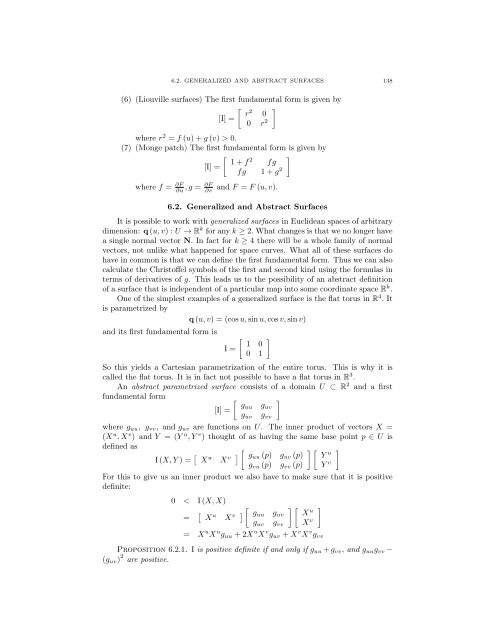Lecture Notes for 120 - UCLA Department of Mathematics
Lecture Notes for 120 - UCLA Department of Mathematics
Lecture Notes for 120 - UCLA Department of Mathematics
Create successful ePaper yourself
Turn your PDF publications into a flip-book with our unique Google optimized e-Paper software.
6.2. GENERALIZED AND ABSTRACT SURFACES 138<br />
(6) (Liouville surfaces) The first fundamental <strong>for</strong>m is given by<br />
apple r<br />
2<br />
0<br />
[I] =<br />
0 r 2<br />
where r 2 = f (u)+g (v) > 0.<br />
(7) (Monge patch) The first fundamental <strong>for</strong>m is given by<br />
apple 1+f<br />
2<br />
fg<br />
[I] =<br />
fg 1+g 2<br />
where f = @F @F<br />
@u<br />
,g =<br />
@v<br />
and F = F (u, v).<br />
6.2. Generalized and Abstract Surfaces<br />
It is possible to work with generalized surfaces in Euclidean spaces <strong>of</strong> arbitrary<br />
dimension: q (u, v) :U ! R k <strong>for</strong> any k 2. What changes is that we no longer have<br />
asinglenormalvectorN. In fact <strong>for</strong> k 4 there will be a whole family <strong>of</strong> normal<br />
vectors, not unlike what happened <strong>for</strong> space curves. What all <strong>of</strong> these surfaces do<br />
have in common is that we can define the first fundamental <strong>for</strong>m. Thus we can also<br />
calculate the Christ<strong>of</strong>fel symbols <strong>of</strong> the first and second kind using the <strong>for</strong>mulas in<br />
terms <strong>of</strong> derivatives <strong>of</strong> g. This leads us to the possibility <strong>of</strong> an abstract definition<br />
<strong>of</strong> a surface that is independent <strong>of</strong> a particular map into some coordinate space R k .<br />
One <strong>of</strong> the simplest examples <strong>of</strong> a generalized surface is the flat torus in R 4 . It<br />
is parametrized by<br />
q (u, v) = (cos u, sin u, cos v, sin v)<br />
and its first fundamental <strong>for</strong>m is<br />
I=<br />
apple 1 0<br />
0 1<br />
So this yields a Cartesian parametrization <strong>of</strong> the entire torus. This is why it is<br />
called the flat torus. It is in fact not possible to have a flat torus in R 3 .<br />
An abstract parametrized surface consists <strong>of</strong> a domain U ⇢ R 2 and a first<br />
fundamental <strong>for</strong>m<br />
[I] =<br />
apple<br />
guu<br />
g uv<br />
where g uu , g vv , and g uv are functions on U. The inner product <strong>of</strong> vectors X =<br />
(X u ,X v ) and Y =(Y u ,Y v ) thought <strong>of</strong> as having the same base point p 2 U is<br />
defined as<br />
I(X, Y )= ⇥ X u X ⇤ apple apple v g uu (p) g uv (p) Y<br />
u<br />
g vu (p) g vv (p) Y v<br />
For this to give us an inner product we also have to make sure that it is positive<br />
definite:<br />
0 < I(X, X)<br />
g uv<br />
g vv<br />
= ⇥ X u X ⇤ apple apple v g uu g uv X<br />
u<br />
g uv g vv X v<br />
= X u X u g uu +2X u X v g uv + X v X v g vv<br />
Proposition 6.2.1. I is positive definite if and only if g uu + g vv , and g uu g vv<br />
(g uv ) 2 are positive.
















